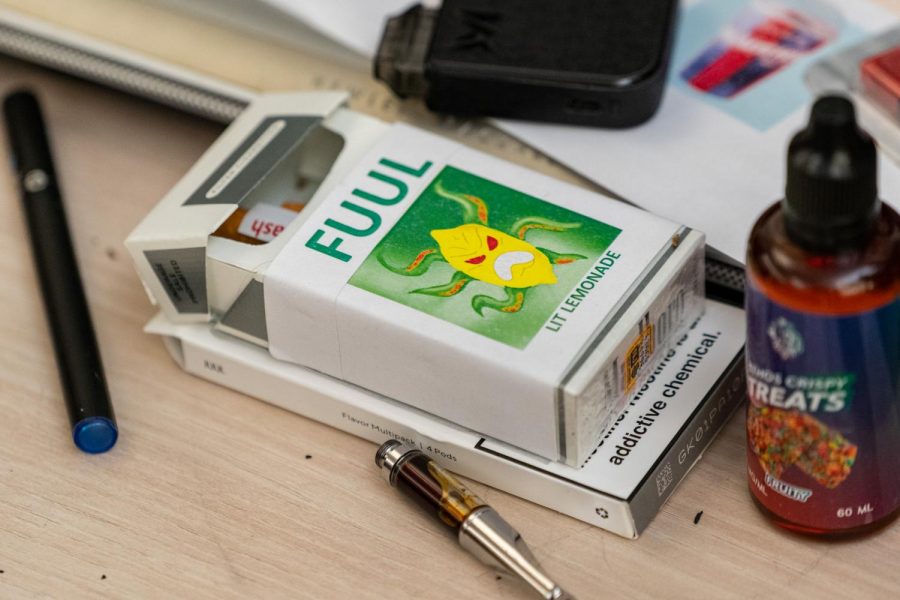With teen use of vaping growing, so is evidence of its serious health risks
E-cigarettes including flavored products now banned.
E-cigarettes, electronic nicotine delivery systems more commonly known as “e-cigs” are a new vaping technology developed as an alternative to smoking. With only ten years of marketing in the United States, limited research has been conducted on vaping and its effects on the human body. This lack of knowledge on vaping and its potential toxicity on the body has lead to beliefs that vaping is harmless or even beneficial. However, recent studies have advocated against that belief.
Vaping is trending across the youth of America; “In the 2017-2018 school year, over 30 percent of high school seniors from across Westchester reported having vaped in the last month. 12 percent of eighth-grade students and 22 percent of tenth-grade students reported vaping in the past month” said Dr. Stumacher, Chief of Pulmonary and Critical Care at Northern Westchester Hospital. This vaping epidemic has infiltrated numerous high schools with students disguising vape pens as highlighters, inhalers, lipsticks and USB drives. Vaping has gained a reputation of being entertaining and cool, however inhaling the chemicals vapes contain poses a number of health risks.
It is a common myth that the action of vaping is merely inhaling and exhaling water vapor. While a typical vape does contain water vapor, it also consists of other chemicals such as propylene glycol, glycerine, nicotine, and a variety of flavoring chemicals. Recent studies have shown that when propylene glycol and glycerine are heated and vaporized inside the “devil’s coil” section of a vape, they become acetylene and formaldehyde which are both carcinogenic. In addition, the addictive substance nicotine keeps its users hooked to vaping, allowing the chemicals to further damage lung tissue. The primary reason teens are so consumed by the craze of vaping are the flavoring chemicals. With over 7,000 flavors, the youth of America are encouraged to inhale these aerosols by attractive labels and advertisements published by the FDA that help appeal vaping to teens. Little research has been conducted on the effects of the flavoring chemicals, but recent studies have indicated that three specific flavoring chemicals are extremely toxic: cinnamon, vanilla, and buttery flavors. The human lungs are not designed to inhale any other gases besides oxygen, nitrogen and a few additional gases which compose the Earth’s atmosphere. Therefore, it is astonishing that anyone would believe inhaling anything other than air would not have its consequences on the pulmonary tract of the human body.
E-cig aerosols could possibly cause vapers to experience the same respiratory symptoms as conventional smokers. Two main mechanisms the body uses to protect against foreign substances are mucus production and clearance by tiny hairs called cilia. Inhaled pollutants such as smoke and chemical fumes kill cilia, allowing mucus to accumulate in thin airways called bronchioles. When substantial quantities of mucus accumulate in the bronchioles, a cough develops to clear the sputum out. This is called “smoker’s cough” (Nursing Times, 2003).
The cinnamon flavoring chemical cinnamaldehyde, like cigarette smoke, also kills cilia. Senior researcher Ilona Jasper at University of North Carolina School of Medicine exposed the aerosolized chemical to lab-grown human lung cell cultures. After exposure, the cilia experienced greatly reduced function. Inhaling the cinnamon-flavored e-liquids induced severe adverse effects on the lung (Thompson, 2018).
Reducing the cilia in lung airways leads to possible respiratory conditions such as asthma and bronchitis. Chronic bronchitis is typically referred to as “smoker’s cough,” and Dr. McConnell from the University of Southern California conducted a study in L.A. with his team of researchers to find signs of “smoker’s cough” in teenage vapers. 2,000 students were asked about their vaping habits and respiratory symptoms. Anyone reporting a daily cough for at least three straight months was judged to have chronic bronchitis. Students complaining of persistent phlegm or congestion not accompanied by a cold were also suspected of having chronic bronchitis. Approximately 500 students said they had vaped at some point and about 200 had vaped within the past 30 days. The recent vapers were about twice as likely to have “smoker’s cough” than those who have not vaped at all. It was found that vapers show some of the same lung symptoms as cigarette smokers (Konkel, 2017).
In addition to negative respiratory health effects, vaping impairs wound healing. Dr. Rahman from the University of Rochester grew lung fibroblast cultures and created lesions in the cells to mimic a wound. The cultures were then exposed to e-cig vapors and it was discovered that the wound did not heal. Rahman noticed that some of the fibroblast mitochondria had been destroyed by the vapors, causing the cells to lose energy before closing the wound. Rahman worries this could be the case in humans as well (Konkel, 2017).
In a 2018 study conducted by researchers at the University of Rochester, the three most toxic flavors were found to be cinnamaldehyde (cinnamon), 0-vanillin (vanilla) and pentanedione (buttery flavor). During this study, two monocytic cell lines—Mono Mac 6 (MM6) and U937—were exposed to a series of e-cig flavorings. The cells’ reactions were observed, and the three flavors were found to have triggered inflammatory and oxidative responses in the cells. Observing the cell’s reactions consisted of measuring the secretion of interleukin 8 (IL-8) which is the inflammatory response, the cytotoxicity assessing by the cell’s viability, and the potential to cause oxidative stress by measuring the reactive oxygen species (ROS) production (Frontiers, 2018). Oxidative stress occurs when the human body metabolizes oxygen and produces ROS surpassing the number of antioxidants provided by the body. An excess of ROS damages cells as a result. Increased ROS production can come from the body fighting off polluting aerosols such as e-cig vapor, and creating inflammation during the process.
The FDA (Food and Drug Association) does not strictly regulate e-cig flavorings. Since flavors like cinnamon and vanilla are considered safe to ingest, the FDA classifies them as safe to vape. However, in a gaseous state, these chemical flavorings are harmful to the lungs. They cause inflammation of the lung tissue, kill cilia, and cause cytotoxicity and even cell death. In addition, most e-cigs contain the chemical diacetyl which can cause bronchiolitis obliterans or “popcorn lung” when inhaled.
In a sense, vaping is even more dangerous than smoking since there is not yet products or systems in place to wean a user off an e-cig. E-cigs are the alternative.
Hi! I'm Jamie. From a young age, I enjoyed writing pretend "newspapers" for my family and neighbors. I always loved writing and am thrilled to be a part...













